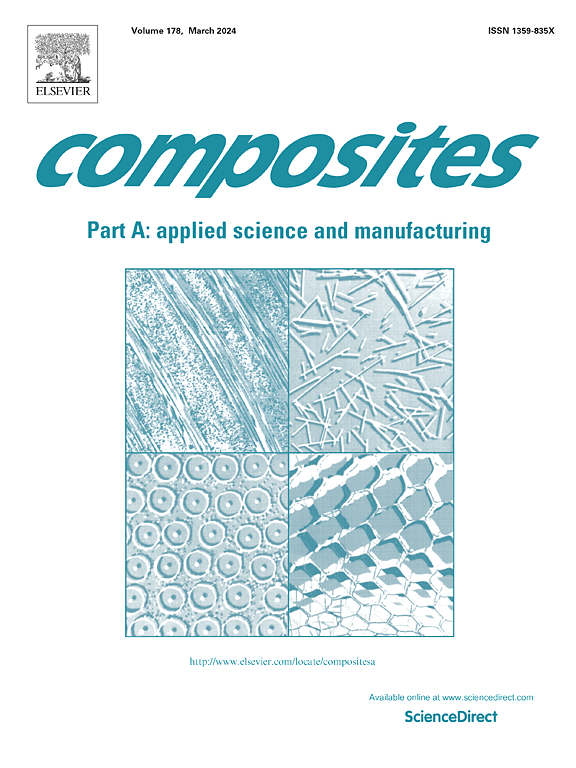Low-cost multifunctional antimony-doped tin oxide/polyacrylamide-chitosan double-network hydrogels with good mechanical properties and excellent electromagnetic interference shielding performance in terahertz band
IF 8.1
2区 材料科学
Q1 ENGINEERING, MANUFACTURING
Composites Part A: Applied Science and Manufacturing
Pub Date : 2025-05-08
DOI:10.1016/j.compositesa.2025.109018
引用次数: 0
Abstract
Researchers have recently developed various methods to incorporate conductive fillers into hydrogel matrices, including metal-based fillers, carbon nanotubes, and two-dimensional materials like MXenes, significantly enhancing their electromagnetic interference (EMI) shielding properties. However, due to the high cost of these fillers, balancing the high EMI shielding (SE), excellent mechanical performance, and low production costs remains a significant challenge, hindering the widespread industrial application of such hydrogels. In this study, we fabricated antimony-doped tin oxide (ATO)/polyacrylamide (PAAm)-chitosan (CS) hydrogels using sodium citrate (Cit) for salting-out, forming double networks and molecular entanglement. The introduction of ATO and the salting-out effect of Cit not only endowed the hydrogel with excellent mechanical properties (strength > 1.5 MPa) but also enhanced its conductivity and EMI shielding effectiveness while maintaining overall low production costs. The hydrogel achieved a 60.2 dB of EMI SE in the 0.1–1.0 THz range, with the price per milliliter of conductive filler being approximately 0.2 % of that in hydrogels incorporating MXenes or reduced graphene oxide. Notably, the hydrogel also demonstrated excellent strain-sensing capabilities. Combining the outstanding properties above, the gel presents a promising candidate for next-generation flexible electronic device shielding applications. It has significant potential for industrial adoption as a cost-effective EMI shielding material.
低成本多功能锑掺杂氧化锡/聚丙烯酰胺-壳聚糖双网水凝胶具有良好的力学性能和优异的太赫兹电磁干扰屏蔽性能
研究人员最近开发了各种方法将导电填料纳入水凝胶基质,包括金属基填料、碳纳米管和二维材料(如MXenes),显著提高了它们的电磁干扰(EMI)屏蔽性能。然而,由于这些填料的高成本,平衡高EMI屏蔽(SE),优异的机械性能和低生产成本仍然是一个重大挑战,阻碍了这种水凝胶的广泛工业应用。本研究采用柠檬酸钠(Cit)盐析法制备了掺杂锑的氧化锡(ATO)/聚丙烯酰胺(PAAm)-壳聚糖(CS)水凝胶,形成了双网络和分子纠缠。ATO的引入和Cit的盐析作用不仅使水凝胶具有优异的力学性能(强度>;1.5 MPa),但也提高了其导电性和EMI屏蔽效能,同时保持整体低生产成本。该水凝胶在0.1-1.0 THz范围内实现了60.2 dB的EMI SE,每毫升导电填料的价格约为含有MXenes或还原氧化石墨烯的水凝胶的0.2%。值得注意的是,水凝胶还表现出出色的应变传感能力。结合上述突出的性能,凝胶是下一代柔性电子器件屏蔽应用的有希望的候选者。作为一种具有成本效益的电磁干扰屏蔽材料,它具有巨大的工业应用潜力。
本文章由计算机程序翻译,如有差异,请以英文原文为准。
求助全文
约1分钟内获得全文
求助全文
来源期刊

Composites Part A: Applied Science and Manufacturing
工程技术-材料科学:复合
CiteScore
15.20
自引率
5.70%
发文量
492
审稿时长
30 days
期刊介绍:
Composites Part A: Applied Science and Manufacturing is a comprehensive journal that publishes original research papers, review articles, case studies, short communications, and letters covering various aspects of composite materials science and technology. This includes fibrous and particulate reinforcements in polymeric, metallic, and ceramic matrices, as well as 'natural' composites like wood and biological materials. The journal addresses topics such as properties, design, and manufacture of reinforcing fibers and particles, novel architectures and concepts, multifunctional composites, advancements in fabrication and processing, manufacturing science, process modeling, experimental mechanics, microstructural characterization, interfaces, prediction and measurement of mechanical, physical, and chemical behavior, and performance in service. Additionally, articles on economic and commercial aspects, design, and case studies are welcomed. All submissions undergo rigorous peer review to ensure they contribute significantly and innovatively, maintaining high standards for content and presentation. The editorial team aims to expedite the review process for prompt publication.
 求助内容:
求助内容: 应助结果提醒方式:
应助结果提醒方式:


